I spent all day yesterday, April 14, in writer’s panels and workshops at Norwescon 40. It was intense and exhausting, but time well-spent. I attended three workshops, seven panels and a reading in the twelve hours I was there. Except for an hour break to eat a burger at six, I was in meeting rooms all day.
I got a late start and arrived at the DoubleTree by Hilton Seattle Airport, in SeaTac, Washington, just before ten. The parking lot was full, and, rather than go looking for parking elsewhere, I did valet parking. It cost $30—I’ll plan better next time. The hotel is a great venue for the conference, with lots of rooms for the panels and other attractions. The location is good for folks flying in—it is right across the street from SeaTac International Airport—but a little inconvenient for people getting there from Seattle. It would take nearly an hour-and-a-half for me to use public transportation to get there—versus twenty-five minutes by car—requiring transferring in downtown Seattle from the bus to light rail, then walking a fair distance once I got to SeaTac. I sometimes think the transit system is rigged in favor of forcing people to use cabs or Uber instead of mass transit to get to the airport.
I arrived at the conference checkin just in time to get my ID before my first panel started. Checkin was a breeze—I had printed and signed my consent form before arriving—with a very short wait in line. After another quick stop to confirm my workshops, I found my way to the conference rooms.
“Story Form, and the Pros and Cons of Each” was my first panel. It was moderated by Mark Teppo. The rest of the panel included Caroline M. Yoachim, Peter Orullian, Nancy Kress and Esther Jones. The discussion was about different forms of narrative fiction—novel, flash, short story, novelette—and how they are similar or different. One of the points everyone agreed on—no matter the length of the story—was that the ending is very important, so put a fair amount of work into it. The beginning is also very important. Everyone agreed you need to pull the reader in, pretty much immediately. You’ve got three paragraphs to hook the reader (or agent), or they’ll move on to something else.
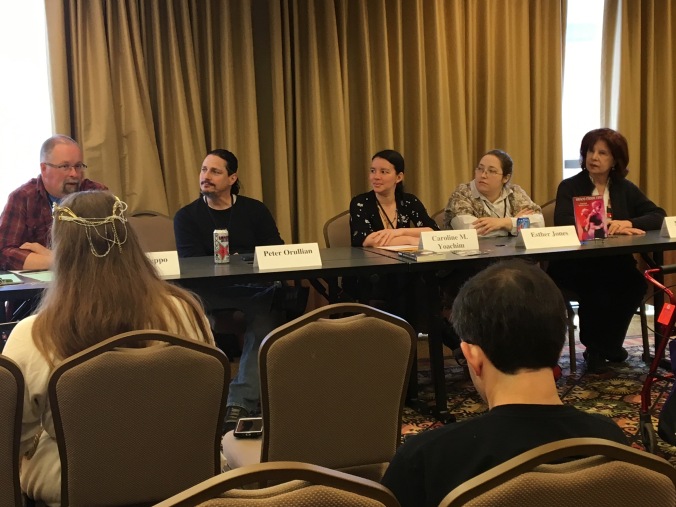
At eleven, I attended my first workshop, “Escaping the Cage – Write a Short Story”, with Patrick Swenson. It was an intense hour going through several exercises that are meant to set the stage, provide a middle and follow through to a conclusion, for a short story—all within an hour. “The Cage” refers to the predicament plaguing your character at the start of the story. We spent five minutes writing this before moving on to “The Escape,” where we wrote for another ten minutes about how the character makes a first attempt to get out of “The Cage.” The first attempt is a miserable failure and might even make things worse. “The Quest” comes next, with fifteen minutes of challenges and learning, including another failed attempt to solve the problem presented in “The Cage.” In part four, “The Dragon,” the hero comes face-to-face with the problem and has the know-how to kill it, either figuratively or literally. We took twenty minutes to complete this. As a wrap-up, we spent the final five minutes on “Home,” where the hero is validated at a homecoming—the awards ceremony at the end of the first Star Wars movie is the perfect example of this. I ended this workshop with a skeleton of a short story about a character I am going to add in the third of The Wolf Dream Books. It is by no means complete, but I will flesh it out and, hopefully, make it into a real short story. I haven’t figured those out yet, so this workshop gave me some tools to make progress there.
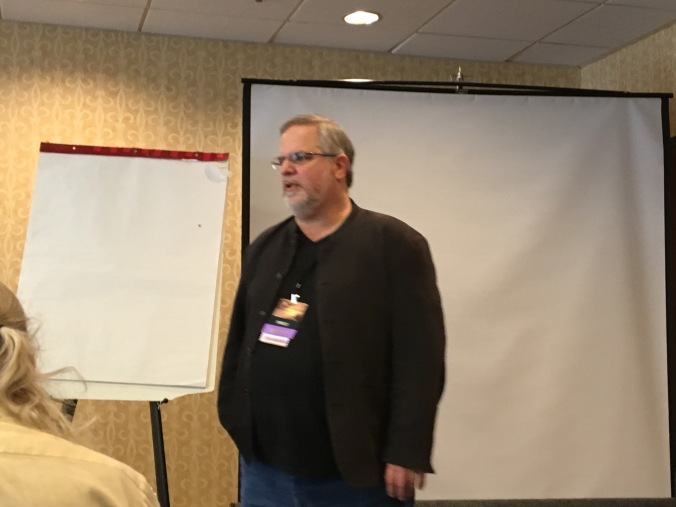
My noon hour was spent in another workshop, “Fear and Writing in Les Genres,” presented by my friend, Evan J. Peterson. Evan writes a lot of speculative fiction, including a lot of horror. His about-to-be-published book, “PrEP Diaries,” is decidedly non-fiction—in it, he describes how PrEP is changing what it means to have safe sex. He moderates “Shriek: Women in Horror,” that explores the roles of women in horror films. He co-moderates the monthly film series with Heather Marie Bartels at Naked City Beer. In the workshop, he explored the “Three Levels of Scare”—attributed to Stephen King—Easiest – revulsion, gore, torture; Intermediate – actual horror, that moment when what you were afraid would happen, is happening, or confronting the fear thing; and Most Difficult – suspense, or horror not yet faced (being chased or whatever). After some discussion around what type of horror an author is trying to present, based on which audience is being engaged, we moved on to some examples of very short works. This was followed by a couple of exercises that helped the students come to grips with their own fears about writing. This workshop segued into the next panel nicely.

In “Horror’s Role in Perpetuating Fear of the Other,” Arinn Dembo moderated a panel, which included Tegan Moore, J. F. High, Evan J. Peterson and Jason Bourget, in a discussion about how minorities—of all kinds, including racial, religious, disabled— have been portrayed in horror as the evil. This has been done both openly and through metaphor and allegory, to create an Us vs. Them narrative. The panel talked about how that has rippled out into a larger cultural narrative. The often mentioned “Get Out” is a new horror film that turns this upside-down, portraying the Black person as the victim, and the whites as crazy, evil monsters. Kudos to writer/director Jordan Peele for the care he took in the making of this film. All the panelists agreed that, when writing horror, great care should be taken to not perpetuate the tropes and stereotypes that have been used in the past.
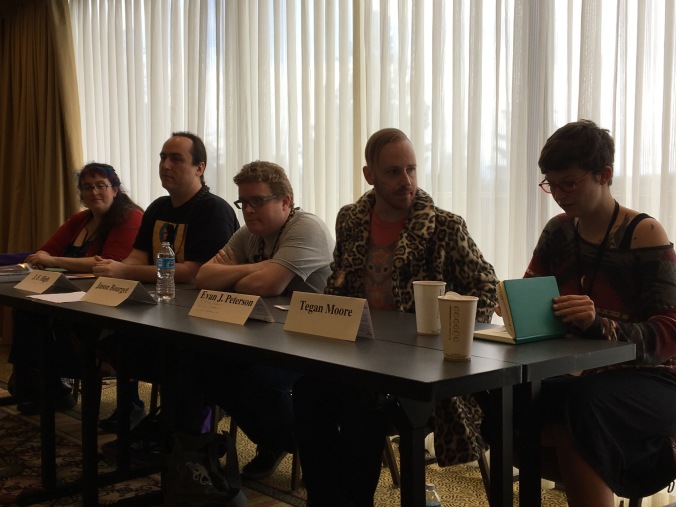
My third writing workshop, “Diversity and Narrative Voice” was with Nisi Shawl. She is a well-known author and writing teacher—see WritingTheOther.com for current classes—whose debut novel Everfair, is a finalist for the 2016 Nebula Award. For the discussion, she introduced the things that define “other”—Race, Orientation, Age, Ability, Religion, and Sex (gender). These are the elements of character to consider when writing about a character that is not “the unmarked state,” which is to say the dominant paradigm. In general terms, this implies white, but could also mean male, age twenty-five to forty, christian—whatever the “default” image the general audience would assume. The narrative voice is also a consideration when writing about “the other.” It is usually written in our culture’s “unmarked state.” Be mindful to ensure that this voice conveys and facilitates the inclusionism you want to portray. As an exercise, students wrote a scene based on a photograph, first from the perspective of one of the characters in their work in progress, then from either a different character or from the original character with one or more of their defining factors changed, e.g., a young man, then an elderly woman. I noticed the scene perspective changed drastically from my vampire seeing the location in my photo, to my little girl experiencing the same place at the same time.
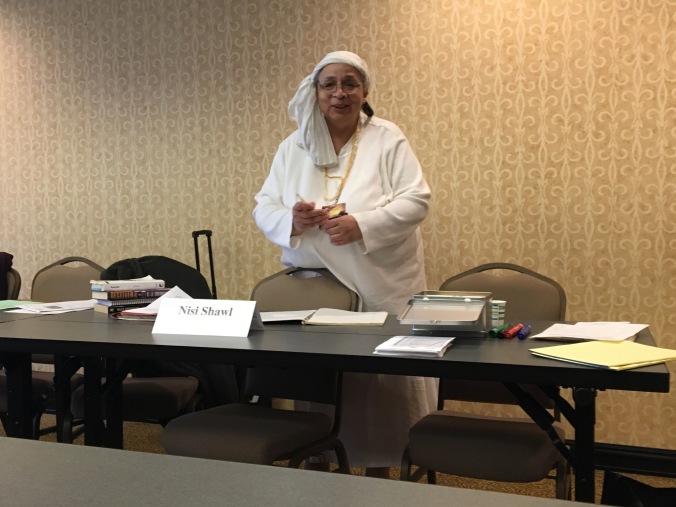
“Shady Characters” was a fun panel. Besides moderator Raven Oak, the panel included Kat Richardson, Tod McCoy and PJ Manney. In it, we discussed what goes into the creation of scoundrels, tricksters and rogues, and why they are fan favorites. In general, a writer needs to be careful not to make the hero too “clean.” All characters have flaws, so don’t leave them out. They add complexity and conflict to the character and to the story. One example of this was Princess Leia in the original Star Wars movie. The panelists agreed she would have been a lot more interesting if she had at least one flaw. An interesting part of the discussion was around whether the scoundrel is being malicious or selfish, or if he believes his actions are necessary, whether or not he considers them “good.” All characters believe they are the hero.
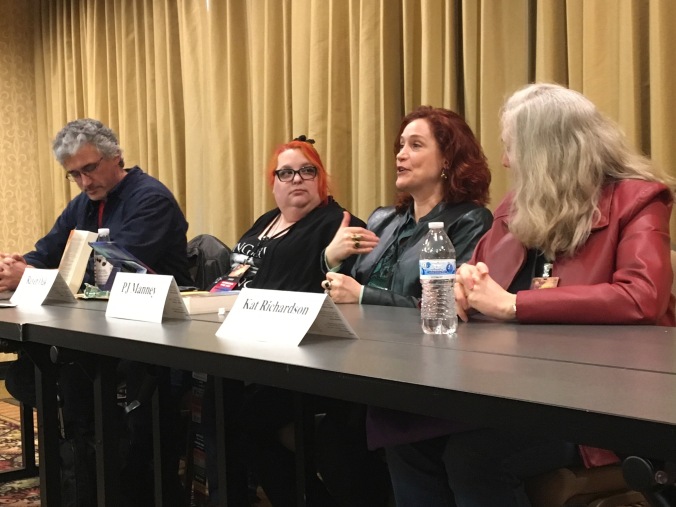
“Writing LGBTQ Characters in the Post-Patriarchy” was my next panel. It was moderated by Dean Wells. The panelists were Evan J. Peterson, Sienna Saint-Cyr and John (J.A.) Pitts. It was an interesting discussion around the rather sudden influx of “the other” in modern media, including writing, stage, film, television, ads and, to a lesser degree, comic books. The panel suggested it might be partly due to societal changes, but also changes in media, which have allowed unbridled creativity and access to media on the internet. Early instances of inclusion were noted to have presented those outside the norms of the last century as clowns or villains, but today, those same characters have become part of the fabric of storytelling. They are simply part of the story and might even occupy the coveted position of main protagonist.

I decided to take a break from characters to attend “Outlining for Pantsers.” Manny Frishberg moderated the panel which also included Evan J. Peterson, Jude-Marie Green, John (J.A.) Pitts. It was interesting to me that the three panelists who don’t regularly outline before they write all expressed a desire to try to do so more often, and the one who always outlines, Pitts, wanted to do less of it. I am definitely a pantser, but perhaps my lack of outlining can be forgiven, since I am so new to the art of writing. I understood all the reasons Pitts gave for why outlining is a good practice. He comes up with a beginning and a solid ending (of course, this could change), and then plans out where the major plot points should occur. Then, he fills in some details about each one, develops characters, and creates the world. It seems like a good way to go and I might try it sometime. The other writers had practices similar to mine—although they all have a lot more experience in story structure than I do—and come up with an idea, start writing, see where it takes you, come up with a likely conclusion, then just fill in things as they come. This process, in my own writing, was wonderful for me—to see the story unfold before my eyes. Now, I am learning what parts of the story are missing. Editing the first draft has been a long and arduous process. Outlining might help some of this.

My final panel was “Diversity 101,” moderated by Sheye Anne Blaze. The other panelists were J. F. High and Evan J. Peterson. This was more about educating people about diversity, in general, as opposed to a discussion about how diversity appears in media. Both Blaze and High are Indigenous people, and both talked about their own experiences of not seeing people like themselves portrayed in media—and, if film characters were Indigenous, they were almost exclusively portrayed by white actors, some great examples of which are Johnny Depp’s portrayals of both Raphael in “The Brave” and of Tonto in “The Lone Ranger.” This led to more talk about appropriation of culture. Interesting to me, some of the audience weren’t familiar with this concept. The panel moved on to women, briefly, then to gender and sexual orientation. Again, an audience member was unfamiliar with some of the terms, such as cis. Since both Blaze and Peterson are not cis, they were able to talk about the issues of being part of “the other” in this regard. It was a good, safe place for people to share what they had experienced with others who were looking for the information.
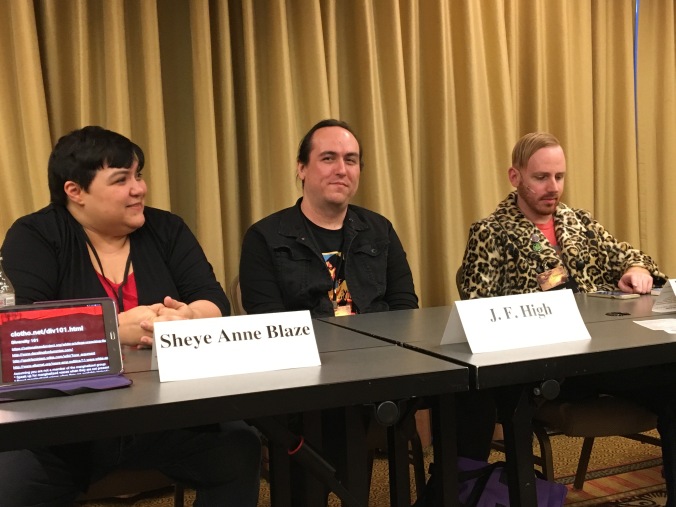
When J. F. High told us he was doing a reading just after my last panel, I decided to stay for a while longer to hear him read. He was originally planning to read something more current, but the recent events in Standing Rock—where ancestral bones were intentionally bulldozed—had shaken him. He decided to share his short story, “NDN Bones,” which is part of the Spring 2016 “Hot Mess” anthology. I’m glad I stayed. His story is about communing with ancestral bones. I could hear the emotion and respect in his voice as he read. It was a moving experience.

I had a great day at Norwescon. It was my first time attending this conference. I wish I had the time to go again today and tomorrow, but family calls. If you’ve never been, try to make it out there before they wrap up tomorrow afternoon.
Copyright ©2014-17 Ramona Ridgewell. All rights reserved.










